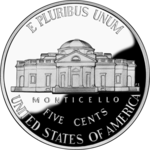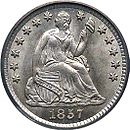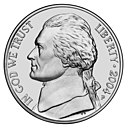5 cent coin (United States)
The five cent piece is a coin of the United States . Its value is equal to one twentieth of a US dollar . The coin, which has been minted from base metal ( copper-nickel ) since 1866 , has been given the nickname nickel , which has established itself as the commonly used name. From 1794 to 1873 a silver coin called a half dime was minted. The portrait of Thomas Jefferson , the third US President , has been depicted on the obverse of the coin since 1938 and his country residence, Monticello, on the reverse (with a brief interruption in 2004/05) .
Half dime
In 1792, the Coinage Act laid the legal basis for minting US coins. This included a "Disme" (tenth dollar, now called Dime ) and a "Half Disme". This year, however, only trial coins were produced.
The first half dimes for circulation were minted in 1795. The early editions all showed the Liberty on the obverse and a bald eagle on the reverse. After the Liberty portrait has been designed, these types become “Flowing Hair Half Dime” (1794–1795), “Draped Bust Half Dime” (1796–1805) and “Capped Bust Half Dime” (or “Liberty Cap Half Dime”, 1829) -1837) called. They had no value, with the exception of the "Capped Bust Half Dime", on which the inscription "5 C." was written.
The “Seated Liberty Half Dime” (1837–1873) showed a seated Liberty on the front and the wreathed value indication “Half Dime” on the back. After the 5-cent coin made of copper nickel was introduced in 1865, the silver half dime was minted for a while, but was finally discontinued in 1873.
The half dime was minted from 900/1000 pure silver and initially weighed 1.34 grams. In 1853 the weight was reduced to 1.24 grams.
Shield Nickel (1866–1883)
The American Civil War led to a shortage of silver, so the search for a new coin metal for the 5-cent piece. A copper-nickel alloy was chosen , to which the lobbying of the nickel magnate Joseph Wharton contributed , among other things .
The term "nickel" was initially not used specifically for the 5-cent piece, but also for other coins that were temporarily minted from cupronickel in the 19th century, namely the 1-cent piece (1859–1864) and the 3 -Cent-Piece (1865-1889). When these disappeared, the name stuck to the 5-cent piece and is now used exclusively for this, although in 1965 the dime and quarter dollar and in 1971 the half dollar and dollar switched from silver to copper-nickel.
The "Shield Nickel" was designed by James B. Longacre . It shows a coat of arms on the front and the value number surrounded by 13 stars on the back. In the 1866 edition and part of the 1867 edition, there were also rays between the stars.
Liberty Head Nickel (1883-1913)
The "Liberty Head Nickel" (also called "V-Nickel" because of the Roman numeral) was officially minted from 1883 to 1912. In 1913, however, an unknown quantity of these V-nickels was minted in the Philadelphia Mint without authorization . Five of these are still known today and are among the most valuable coins of all. One was sold for $ 4.15 million in 2005.
Buffalo Nickel (1913-1938)
The type called "Buffalo Nickel" or "Indian Head Nickel" was minted from 1913 to 1938. It was designed by James Earle Fraser and shows an Indian in profile on the front and an American bison on the back . The design had to be changed in the first year of issue. The bison stood on a slightly curved ground, from which the value "Five Cents" stood out and quickly wore off. On the more recent editions, the value is less prominent below a straight line. A well-known variety of this coin that is sought after by collectors is the “three-legged bison” from 1937. A defect on the stamp was removed by polishing, which resulted in almost the entire right front leg disappearing.
Jefferson Nickel (1938-)
The "Jefferson Nickel", minted from 1938 onwards, was designed by Felix Schlag . It shows Thomas Jefferson on the obverse and Monticello , Jefferson's Virginia estate , on the reverse . Schlag's face design, showing Jefferson in profile, was in use until 2004. In 2005 a new portrait was used, which was replaced the next year by the current design, on which Jefferson looks forward.
Wartime nickel
From mid-1942 to 1945, the 5-cent coin was produced in a different composition (56% copper, 35% silver and 9% manganese ) because nickel was important for the war industry. In addition, the mintmark was placed above the building instead of to the right of it as before.
Westward Journey Nickels
The US Mint planned to introduce a new design for the nickel in 2003. By law, it was authorized to do so if a coin had not been changed for 25 years. On the occasion of the 200th anniversaries of the Louisiana Purchase (2003) and the Lewis and Clark Expedition (2004), the new design was supposed to be about opening up American territory to the west. However, there was political opposition because it would have removed Monticello from the coin and because the proposed design (an Indian and a bald eagle facing west) made insufficient reference to the anniversaries. Congressman Eric Cantor from Virginia (where Monticello is located) introduced a law that stipulated that Monticello had to be depicted on coins again from 2006 and that the US Mint would no longer be allowed to change the coin images without the approval of Congress. This delayed the redesign and could no longer be carried out in 2003. After the law was passed, the mint presented two new designs each for 2004 and 2005.
2004 editions
The first edition from 2004 is reminiscent of the Louisiana Purchase and shows on the back a handshake and crossed a tomahawk and a peace pipe , a motif that was adopted from a contemporary peace pipe.
The second edition is reminiscent of the Lewis and Clark expedition and shows the Keelboat in which Lewis and Clark were traveling.
Issues from 2005
For the two issues from 2005, not only the back but also the front was changed. She now shows a profile picture of Jefferson that fills the entire left half of the coin. The word "Liberty" is depicted in Jefferson's handwriting.
On the back of the first issue, as on the Nickels from 1913–1938, a bison can be seen.
The second edition is again about the Lewis and Clark Expedition. The reverse motif shows the Pacific coast with the inscription “Ocean in view! O! The Joy! ". These words are taken from a journal entry by William Clark , who wrote this down when the expedition reached the Pacific Ocean .
New portrait of Jefferson (2006–)
Since 2006, the Monticello motif by Felix Schlag can be seen on the back. The stamp has been reworked so that the coin image is sharper and more details can be seen. The front has been redesigned. It now shows Jefferson looking ahead. It was designed by Jamie Franki, the portrait being based on a painting by Rembrandt Peale .
Technical specifications
The coin consists of a cupronickel alloy with proportions by weight of 75% copper and 25% nickel . It weighs exactly 5 grams. The diameter is 21.21 millimeters and the thickness 1.95 millimeters. The edge is smooth.
Rising metal prices from 2006 onwards meant that the metal value of a nickel exceeded its face value. To prevent coins from being melted down, the US Mint issued rules that forbid one cent and five-cent piece to be melted down or exported in large quantities.
Individual evidence
- ↑ CoinCollector.org - 1913 Liberty Nickel Sold For Record Price
- ↑ US Mint: Circulating Coins - Nickel
- ↑ US Mint: United States Mint Moves to Limit Exportation & Melting of Coins















